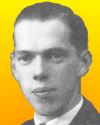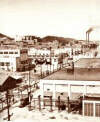
On 1 Aug 1873, English-American inventor Andrew Smith Hallidie, successfully tested a cable car he had designed to solve the problem of providing mass transit up and down San Francisco’s steep hills. He not only invented, but also manufactured and patented the first cable car and its system of wire ropes, pulleys, tracks, and grips that made it possible. Hallidie, an engineer and one-time miner, realized the need on one foggy day in 1869 when he watched in horror as horses pulling a carriage up one of the City’s steep grades slipped on the wet cobblestoned street, the heavy carriage rolled backward downhill and the five horses dragged behind it suffered fatal injuries.
Hallidie developed a system of streetcars on rails, fitted with a mechanical device that gripped an underground endless moving cable to travel, and released to stop. The cable passed around pulleys and was driven by a large wheel at an engine house.
This was a big challenge, but earlier in his career had much successful experience with the wire rope he manufactured in the application of cable drawn ore cars in mines. He had learned the business of making wire rope from his father before moving to the U.S. in 1853. He then designed and built wire suspension bridges and flumes. He began manufacturing wire rope in 1857. Hallidie also developed a method of moving freight over canyons using an endless wire rope, and inventions for the transmission of power with wire rope, which seeded his idea for cable cars.
A short, but informative biography of Andrew Smith Hallidie as the Practical Hero of Invention, from Heroes of California (1910) gives more background. It will show you how the cable cars of San Francisco did not come into existence from scratch. Rather, they were part of a progression in Hallidie’s career of experience with wire rope in static and dynamic uses.

On 1 Aug 1818, Maria Mitchell was born, who became the first woman to be a professional astronomer in the United States. At first she pursued an amateur interest, but on 1 Oct 1847, at age 29, she gained world-wide fame for being the first to report a comet she had observed. She was also the first female member of the American Association of Arts and Sciences.
Today's book pick is: Maria Mitchell: A Life in Journals and Letters, by editor Henery Albers, who extracts from her diaries a narrative of her inspiration. Maria Mitchell was such an extremely gifted,intelligent and independent woman that she taught herself the mathematics and calculus necessary to extract information from her observational data. Her story is so well-told than anyone will be amazed by her achievements and travels abroad. The book may be of particular interest to female readers to learn of the accomplishments of a woman at a time when science was so dominated by males.
It is available from Amazon, typically about New from $137.04. Used from $25.00. (As of earlier time of writing - subject to change.)
 | It is not enough to discover and prove a useful truth previously unknown, but that it is necessary also to be able to propagate it and get it recognized. |
 | Part of the strength of science is that it has tended to attract individuals who love knowledge and the creation of it. Just as important to the integrity of science have been the unwritten rules of the game. These provide recognition and approbation for work which is imaginative and accurate, and apathy or criticism for the trivial or inaccurate. … Thus, it is the communication process which is at the core of the vitality and integrity of science. |
 | The cells are thus the stomachs of which the plant has millions like mouths. |
| Before you look at today's web page, see if you can answer some of these questions about the events that happened on this day. Some of the names are very familiar. Others will likely stump you. Tickle your curiosity with these questions, then check your answers on today's web page. | |
| Births | |
 | Georg Charles von Hevesy, born 1 Aug 1885, was a Hungarian-Danish-Swedish chemist who earned the 1943 Nobel Prize for work which greatly advanced understanding of the chemical nature of life processes. For example, using his technique, it was found that the phosphorus content in human blood falls after only 2 hours to a mere 2% of its initial value and gradually changes places with the phosphorus atoms of the tissues, organs and skeleton. He also discovered, with Dirk Coster, the element hafnium (1923). What was the Nobel prize-winning technique he developed? |
 | On 1 Aug 1870, Ilya Ivanovich Ivanov was born, a Soviet biologist who developed a practical procedure for artificially inseminating domestic animals for breeding farm stock. In 1901, Ivanov founded the world’s first centre for the artificial insemination of racehorses. He died in 1932, but in 2005, Moscow newspapers reported that Ivanov had been ordered to research how sperm could be manipulated to produce a super-warrior that would be “a new invincible human being, insensitive to pain, resistant and indifferent about the quality of food they eat.” Which Soviet leader wanted to breed super-warriors? |
| Deaths | |
 | A French inventor (1740-1810) with his younger brother, Étienne, was one of the pioneers of ballooning. On 21 Nov 1783, their balloon carried the first two men on an untethered flight. In the span of one year after releasing their test balloon, these brothers had enabled the first manned balloon flight in the world. Can you name this man? |
 | Richard Kuhn (1900-1967) was a German biochemist awarded the 1938 Nobel Prize for Chemistry for work on carotenoids and vitamins. He had discovered (1933) a third carotene isomer which was called gamma-carotene. However, he did not receive the Nobel diploma and gold medal until 1949. Why was the 1938 award presented to Kuhn in 1949? |
 | A German inventor (1847-1919) went to New York in 1863 and worked in a cigar factory. From his patents on cigar rolling machines he subsequently invented, he earned great sums of money. He devoted his wealth to designing and building theatres, showing his genius for acoustics. He was the grandfather of another famous man who carried his name as the II. That grandson made the name famous through musicals. Can you name these men? |
| Events | |
 | On 1 Aug 1793, the first definition was made for a new unit 1/10 000 000 of the northern quadrant of the Paris meridian (5 132 430 toises of Paris, from the north pole to the equator). The definition was made legal by the French National Assembly on 7 Apr 1795. What was the unit? |
 | On 1 Aug 1943, the groundbreaking ceremony for the first uranium 235 plant took place. (Uranium 235 was needed to build the A-bomb.) The uranium manufacturing facility cost $280,000,000 to build and was completed in the summer of 1944. Where was this plant built? |
 | The 1 Aug 1941 Parade magazine devoted three full pages to “…the Army's most intriguing new gadget.” General Dwight D. Eisenhower said that America couldn’t have won World War II without it. What was was this “gadget” ? |
Fast answers for the previous newsletter for July 31: ticks • vanadium • Kevlar (polyparaphenylene terephthalamide) • steam • none (thousands were issued before the Patent Office began to assign patent numbers) • Dr Hawley Crippen.
 If you enjoy this newsletter, the website, or wish to offer encouragement or ideas, please send feedback by using your mail reader Reply button.
If you enjoy this newsletter, the website, or wish to offer encouragement or ideas, please send feedback by using your mail reader Reply button. Your click on a Facebook, StumbleUpon, or other social button on the site webpages is also a welcome sign of appreciation. Thank you for using them.
© This newsletter is copyright 2020 by todayinsci.com. Please respect the Webmaster's wishes and do not put copies online of the Newsletter — or any Today in Science History webpage. (If you already have done so, please remove them. Thank you.) Offline use in education is encouraged such as a printout on a bulletin board, or projected for classroom viewing. Online, descriptive links to our pages are welcomed, as these will provide a reader with the most recent revisions, additions and/or corrections of a webpage. For any other copyright questions, please contact the Webmaster by using your mail reader Reply button.
--
If you do not want to receive any more newsletters, Unsubscribe
To update your preferences and to unsubscribe visit this link
Executive Real Estate Business Class
-
"It was like a man with wings. It wasn't like anything you'd see on TV or in a monster movie." ...
About the publisher
Search This Blog
Blog Archive
-
▼
2021
(585)
-
▼
August
(32)
- Newsletter for Tuesday 31 August.
- Newsletter for Monday 30 August.
- Newsletter for Sunday 29 August.
- Newsletter for Saturday 28 August.
- Newsletter for Friday 27 August.
- Newsletter for Thursday 26 August.
- Newsletter for Wednesday 25 August.
- Newsletter for Tuesday 24 August.
- Newsletter for Monday 23 August.
- All-New Tonight: 'The Machines That Built America'
- Newsletter for Sunday 22 August.
- Newsletter for Saturday 21 August.
- Newsletter for Friday 20 August.
- Newsletter for Thursday 19 August.
- Newsletter for Wednesday 18 August.
- Newsletter for Tuesday 17 August.
- Newsletter for Monday 16 August.
- Newsletter for Sunday 15 August.
- Newsletter for Saturday 14 August.
- Newsletter for Friday 13 August.
- Newsletter for Wednesday 11 August.
- Newsletter for Tuesday 10 August.
- Newsletter for Monday 9 August.
- All-New Tonight 9/8c: Telephone Wars
- Newsletter for Sunday 8 August.
- Newsletter for Saturday 7 August.
- Newsletter for Friday 6 August.
- Newsletter for Thursday 5 August.
- Newsletter for Wednesday 4 August.
- Newsletter for Tuesday 3 August.
- Newsletter for Monday 2 August.
- Newsletter for Sunday 1 August.
-
▼
August
(32)
-
Blogroll
-
About
HistoryFact










0 comments:
Post a Comment